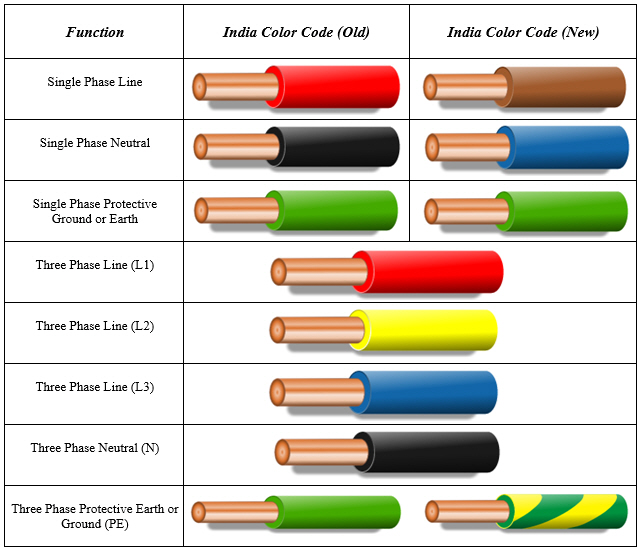Decoding the Mystery of Brown, Black, Blue, and White Wires
Have you ever stared at a tangle of wires, feeling a mix of curiosity and apprehension about their purpose? The world of electrical wiring can seem daunting, but understanding the meaning behind those colorful strands is crucial for any DIY enthusiast or professional electrician. In this comprehensive guide, we'll delve into the realm of brown, black, blue, and white wires, unraveling their significance and equipping you with the knowledge to navigate electrical projects with confidence.
Color codes in electrical wiring aren't random. They're a universal language that helps identify the function of each wire, preventing misconnections and ensuring safety. While the specific meaning of each color can vary depending on the application and local regulations, we'll focus on common conventions to provide a solid foundation.
Often in household wiring, brown wires are utilized for live or hot connections. Black wires might also serve as hot wires, especially in switch legs or in some countries where they are the standard for live wires. Blue is typically associated with neutral connections, providing a return path for the current. White wires generally denote neutral conductors as well, though they can sometimes be used for switched hot wires in specific circuits. Understanding these basic distinctions is the first step towards safe and effective wiring practices.
The history of color-coded wires stretches back to the early days of electrical systems, driven by the need for standardization and safety. As electrical systems became more complex, the potential for misconnections increased, leading to the adoption of color-coding conventions. This critical development significantly reduced the risk of electrical hazards, paving the way for safer and more reliable electrical installations.
The importance of adhering to these color conventions cannot be overstated. Incorrect wire connections can lead to short circuits, blown fuses, damage to appliances, and even electrical fires. Therefore, meticulous attention to detail and a thorough understanding of the color code system are paramount for anyone working with electrical wiring.
One common issue with color-coded wires is fading or discoloration over time, which can make identification difficult. In older installations, the insulation might have deteriorated, obscuring the original color. In these cases, using a multimeter to test the voltage and continuity of each wire is crucial for accurate identification.
Advantages and Disadvantages of Color-Coded Wiring
While color-coded wiring offers significant advantages, there are a few potential drawbacks to consider:
| Advantages | Disadvantages |
|---|---|
| Enhanced Safety | Potential for Color Fading |
| Simplified Troubleshooting | Variations in Local Codes |
| Ease of Installation | Risk of Misinterpretation if Codes Not Followed |
Understanding the purpose of each color within a specific wiring system is paramount. Always consult local electrical codes and regulations to ensure compliance and safe practices. Double-checking your work with a multimeter is an essential step for verifying correct connections and preventing potential hazards.
Frequently Asked Questions:
1. What does a brown wire typically represent? (Usually a live/hot wire)
2. What is the common function of a blue wire? (Neutral connection)
3. Can white wires ever be used for hot connections? (Yes, in specific switched circuits)
4. Why is it important to follow color codes in wiring? (Safety and preventing misconnections)
5. What should I do if the wire colors are faded or unclear? (Use a multimeter to test voltage and continuity)
6. Where can I find information on local electrical codes? (Consult local authorities or certified electricians)
7. What are the potential hazards of incorrect wiring? (Short circuits, fires, appliance damage)
8. How can I improve my understanding of wire color codes? (Consult resources, take courses, seek guidance from experienced electricians)
In conclusion, the seemingly simple color codes of brown, black, blue, and white wires hold significant importance in the world of electrical wiring. Understanding their meanings and adhering to established conventions are critical for safe and effective electrical installations. By learning the language of these color codes, you empower yourself to tackle electrical projects with confidence and ensure the safety of your home or workspace. Remember, thorough research, adherence to local codes, and meticulous attention to detail are essential for successful wiring practices. Never hesitate to seek the advice of a qualified electrician if you encounter any uncertainty or challenges. Investing time and effort in understanding wire color codes is an investment in safety and efficiency.
The unexpected power of cute cat pics aesthetic
Unlocking your potential diploma perguruan lepasan ijazah upsi explained
Discover unique treasures a guide to craft and vendor shows near you
:max_bytes(150000):strip_icc()/color-coding-of-electric-wires-1152300-FINAL-5bbcc3f846e0fb00265e6788.png)













